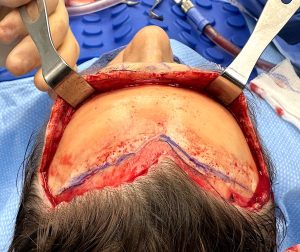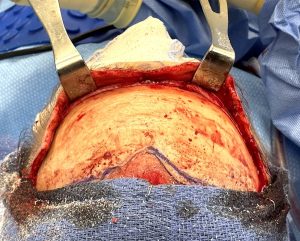Background: While there are many features they define an aesthetically pleasing forehead two of them are of particular relevance. First the length of the forehead, as defined by the vertical distance between the eyebrows and the frontal hairline, should be proportionate to the lower facial thirds. Secondly the slope of the forehead, the relationship between there forward projection between the upper and lower half, should not exceed 0 degrees in profile.
When the length of the forehead becomes greater than a third of the face and/r the slope of the forehead in profile becomes a negative number these are viewed as unaesthetic features. When these two features occur together, as in the case of the frontal bossing patient, the most severe form of aesthetic forehead deformity is created. These two deformities are synergestic…the high hairline makes the upper bony forehead look more prominent while the upper bony protrusion makes the forehead look longer.
The treatment of frontal bossing with a high hairline is the combined hairline lowering and bony bossing reduction. They can be performed through a single incision and improvement is always obtained in both. The only question is the magnitude of change which is highly influenced by the thickness of the scalp and the bone over the bossing.









Key Points:
1) A long forehead is often associated with frontal bossing, both of which make the other look worse.
2) The non-bony forehead reduction technique of frontal hairline advancement is based on the natural flexibility of the scalp…which is highly influenced by ethnicity and skin pigmentation.
3) How much the bony forehead can be reduced depends on the thickness of the frontal bone which often is thinner in frontal bossing.
Dr. Barry Eppley
World-Renowned Plastic Surgeon







